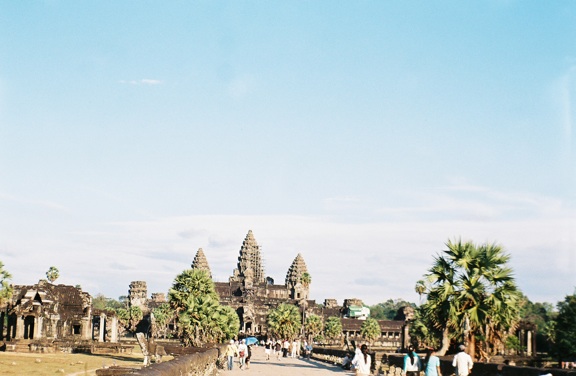
There are a number of ways to get from Phnom Penh to Siem Reap. The fast, but expensive, way is to fly. The slowest way is by boat. Bus is actually both cheaper and faster than the boat. There are various levels of bus service, but USD 11 gets you one with marginally effective air conditioning and meal service (i.e. they give you a small loaf of bread and a bottle of water). The trip took about 5 1/2 hours, including stops at a couple of places that had market stalls (fruit, snack foods, drink, fried tarantulas) and squat toilets.
I'd arranged to stay at the Two Dragons Guest House and they sent a tuk-tuk driver to meet me. The guesthouse is in the Wat Bo area, which is across the river from the main part of town. It's very clean and comfortable, with friendly and helpful staff - well worth the USD 15 a night. It's a pleasant stroll (or a short tuk-tuk ride) to the bustling old market area, which is full of internet cafes, English language bookstores, souvenir shops, restaurants and bars. In fact, one of the streets in the area is called Pub Street. I found Dead Fish Tower, which has a crocodile pit in the bar area, to be the most atmospheric. But the best meal I had was at a place called Aha, which is more or less an Asian tapas bar. I did, however, balk at trying their specialty of green mango salad with dried snake.
Angkor Wat is, of course, the major tourist attraction of Siem Reap. Actually, it is just one of the temples in the area. They were built from around the mid-10th through mid-14th century, with Angkor Wat itself dating to roughly 1150. Your ticket gets you into as many of them as you can see during its validity. You do, however, have to pay your tuk-tuk driver extra if you want to go to some of the more outlying ones. I went for the three day pass at USD 40. There are also one-day and seven-day passes. The multi-day passes save you money, but have to be used on consecutive days.
Many people hire guides, but it is difficult to find a good one. (Your driver generally drops you off at the entrance to a site and waits for you at the exit.) I found that a combination of the extensive descriptions in the Rough Guide and a bit of eavesdropping on tour groups was good enough to know what I was looking at. The site is definitely impressive and its fame is justifiable. That wasn't really obvious to me from the familiar exterior view.

What I hadn't fully grasped was the elaborate carving of the interior of the complex. Every wall is covered with ornate bas reliefs, pretty much from floor to ceiling. The themes are largely mythological, e.g. stories from the Reamkar, visions of heaven and hell, a creation myth ("the churning of the ocean of milk"). I found the amount of detail astounding and spent a few hours wandering around the temple and gawking.
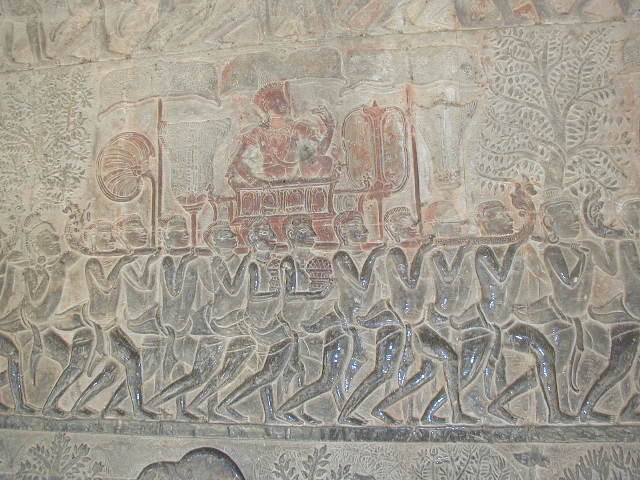
For those of you who are (as I am) fans of The Amazing Race, I should also mention the Chamber of Echoes. This was the site of one of the challenges from a few seasons back and a friend had asked me if I intended to look for it. It was actually not all that hard to find, since it was clearly marked in the guidebook map. You stand in the chamber and thump your chest with your fist three times to hear the echo. You too can have your reality TV moment!
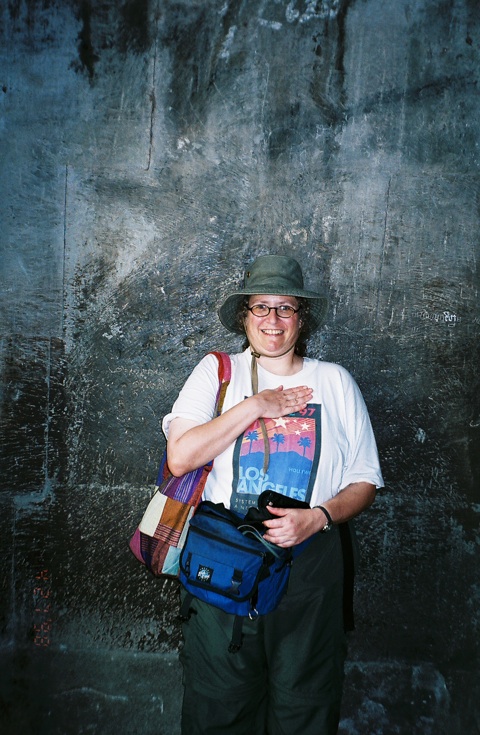
Next up on the standard route is the south gate of Angkor Thom, which is a large walled complex of temples and terraces. The causeway leading in is lined with statues of gods and demons. You can tell them apart because the gods have almond-shaped eyes, while the demons have round eyes. I don't think I need to comment on the racial implications, though I didn't think southeast Asia had much, if any, contact with the West in the 12th century.
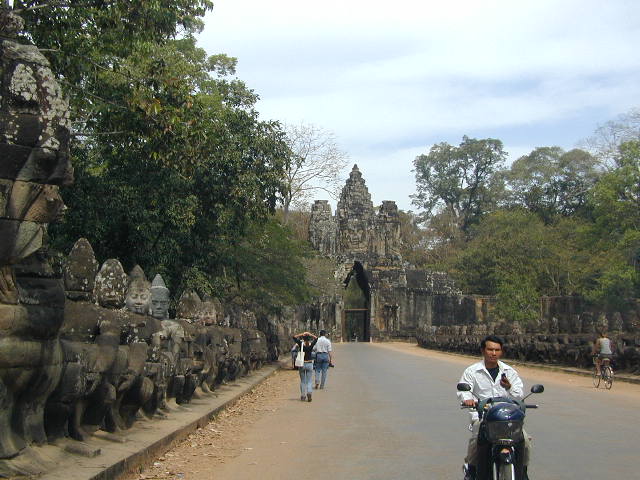
Angkor Thom supposedly translates to "great city" and the complex covers an area of about 3 square miles. There are several terraces and temples inside, the most famous of which is the Bayon.
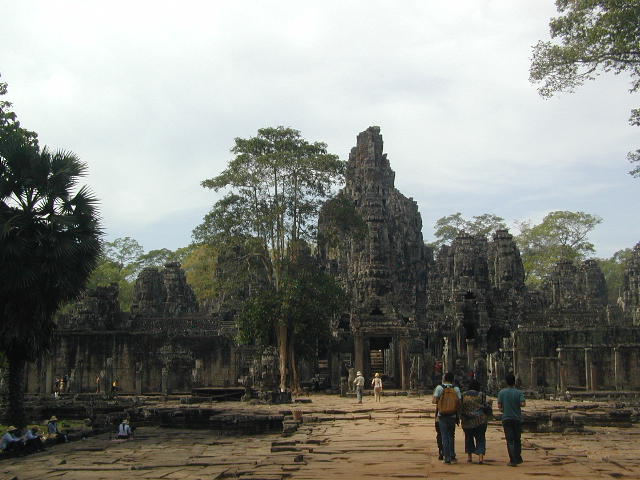
I didn't manage to get any pictures worth showing of the giant Buddha heads on the Bayon towers, but there are also plenty of bas reliefs to see. In addition to Hindu gods and battle scenes, one sees a lot of the celestial dancers called apsaras.
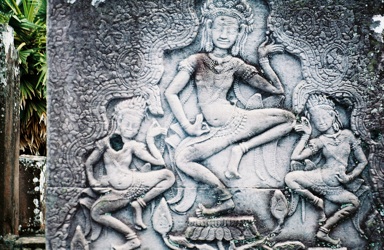
There are several shops and restaurants outside the Bayon exit, by the way, which make for a convenient break. You are also sure to be surrounded by children proffering postcards and books, which prompted me to write this haiku:
Children sell postcards
One dollar will get you ten
in shops, just get one.
To finish up Angkor Thom, you can wander around the back of the Baphuon, a temple that is still being restored and see a giant reclining Buddha. Then there are the Terrace of the Elephants and the Terrace of the Leper Kings, both of which are also elaborately carved. I found that things were starting to blur together for me at this point (which was mid-afternoon) and was glad the three-day pass allowed for me to defer more temple visits in favor of returning to the guest house and taking a nap.
Based on the guidebook description, I wanted to go to Banteay Srai, which is one of the more outlying temples (about 20 miles further on, which takes an hour or so by tuk-tuk). It's well worth the extra cost for the drive, as it is noticeably different in style. Presumably that is because it is older, dedicated in 967 C.E., and more purely Hindu in style. It is the most elaborately decorated of the Angkor temples, with extremely detailed carvings of Hindu gods and floral motifs. There are also several statues of monkey-like temple guardians.
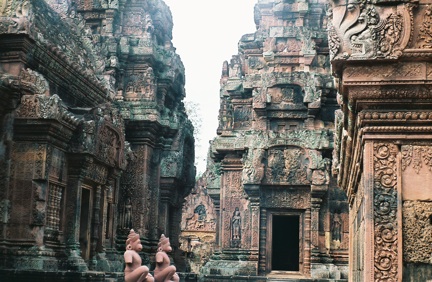
On the way back to town, I stopped at the Landmine Museum. This is a private museum and it costs a dollar to get in. It's owned by a man named Aki Ra, who had been a child soldier laying mines and later learned demining techniques. He went on to found an NGO which takes in children who are victims of mines. The actual displays of disabled mines are less interesting than those stories.
After a stop for lunch, I continued on to Ta Prohm. When the temples were being restored, the decision was made to leave a lot of the encroaching jungle here. The actual structure is, therefore, encased in the roots of kapok trees, which make it particularly atmospheric. While there are fine carvings, the most famous part of Ta Prohm is a corner door, which was used in the Tomb Raider movie.
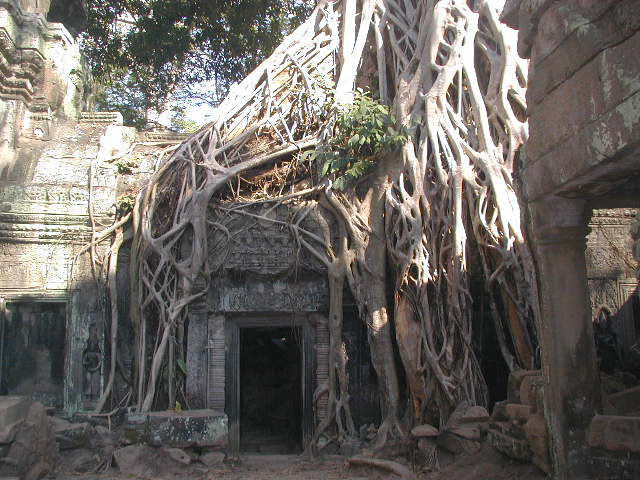
I finished my second day of temple visits with Banteay Kdai. This was really mostly more of the same, with its most distinctive feature being the Hall of the Dancing Girls, which has a particularly large number of apsaras.
My third (and final) day of temple touring involved finishing up the grand circuit by seeing the northern temples I hadn't yet gotten to. I started with Preah Khan. Like Ta Prohm, there are tree roots growing into this temple, but what really makes it unusual is some of the interior features remaining intact, e.g a lingam, a representation of the god, Shiva. Some people believe this is a phallic symbol. Of course, some people also believe that of the Washington Monument, so I will let you judge for yourself.
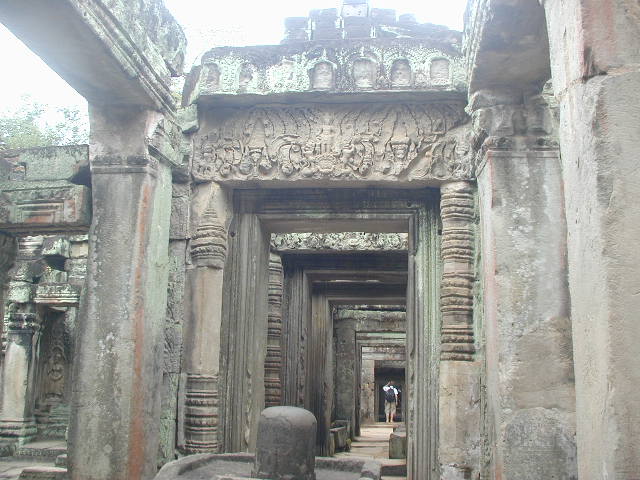
There is also a Buddhist stupa in the center, surrounded by the Hindu temples. And, of course, there are lots of carvings, including a couple that are said to represent the wives of King Jayavarman VII, who had it built.
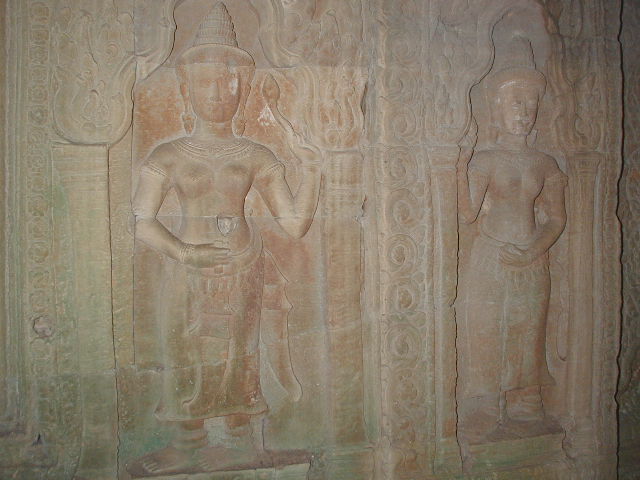
One of the more unusual temples is Neak Pean, which consists of a number of pools. The largest one, in the center, has a large tower with a statue of people clinging to the side of a horse.
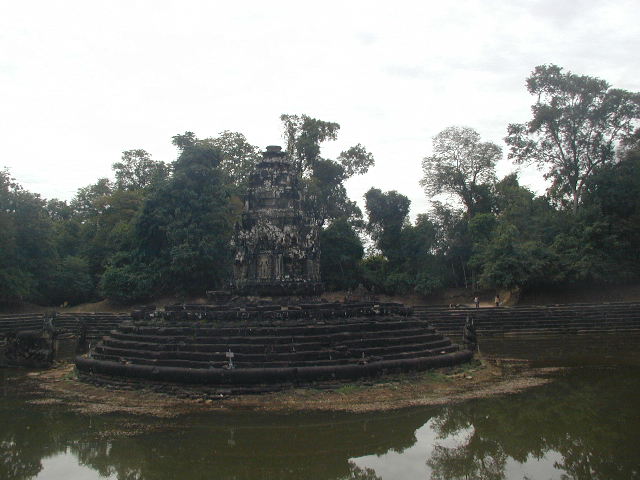
The four smaller pools surrounding the central one each allow you to climb down to see their water spouts. All four are different - a horse, a lion, an elephant, and a human.
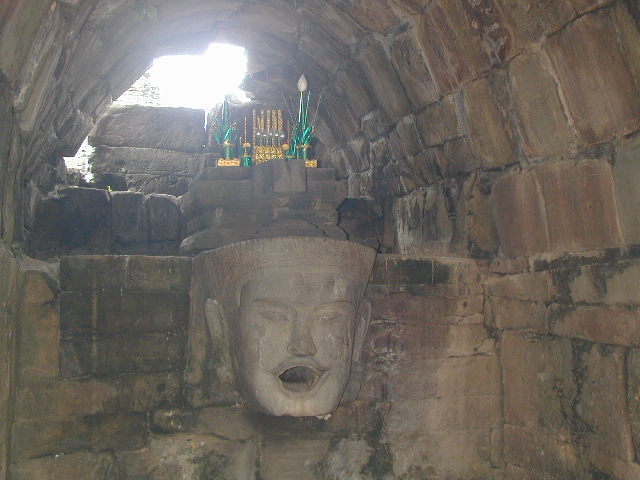
Another style of temple is what is referred to as the "temple mountain." That consists of a series of terraces with tall towers. I visited two of these - East Maban and Pre Rup. The steep, narrow steps make sure you get a good work-out. There is supposed to be a good view from the top of Pre Rup, but it was too cloudy to see much.
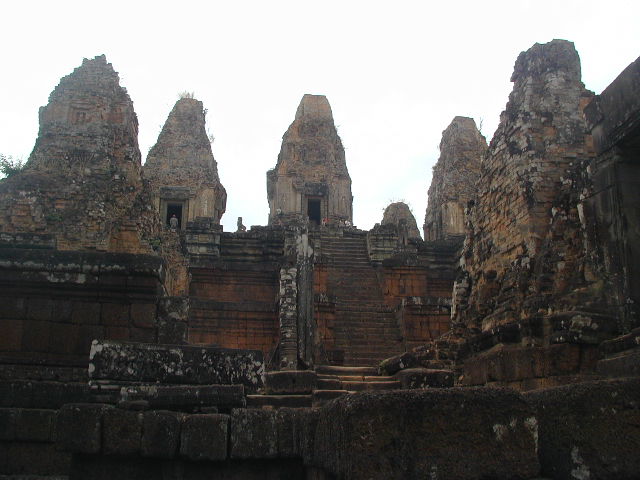
I finished my temple touring with Srah Sang, which is really just a large pool. Overall, I thought the three-day pass was a good choice, allowing me to see a wide range of temples without completely exhausting myself. What impressed me the most, aside from the detail of carving, was the variety of different styles.
I had one more day in Siem Reap, which I devoted to town-based sightseeing and shopping. I went over to Artisans d'Angkor, which offers tours of their crafts workshops and sells high quality (and high priced) crafts. The Old Market was more suited to my budget and I bought the obligatory doll for my collection there. That took some effort since I had to look at everything before deciding which one to buy, at which point I had forgotten where the stall I wanted was. While most of the market is a real food market and only the area closest to the river is devoted to souvenirs, that's still a pretty big area.
One of the other things that makes Asian travel enjoyable is the low cost of spa visits, so I spent part of the afternoon getting a manicure and pedicure. Then I walked up Sivatha Street, which has a mall with a large and well-stocked supermarket. I contemplated tea at the Grand Hotel d'Angkor, but decided it was too pricey. A walk through the Royal Gardens is, however, free.
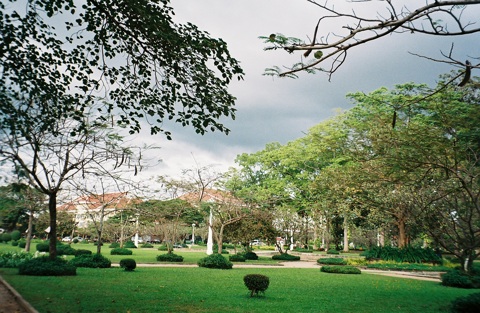
In the morning, I was off to Bangkok. Bangkok Airways made that a little harder than necessary since the check-in clerk had never handled an electronic ticket before. He didn't know that he was supposed to look at my credit card when checking me in, so I ended up being paged and escorted back through security (and passport control) from the departure lounge for him to remedy this. I still had enough time to browse the airport branch of Monument Books, where I found a few children's books of Cambodian folk tales for my collection. Which brings me to the next chapter.
[Back to Previous Chapter | Back to Index | On to Next Chapter ]
last updated 14 February 2010